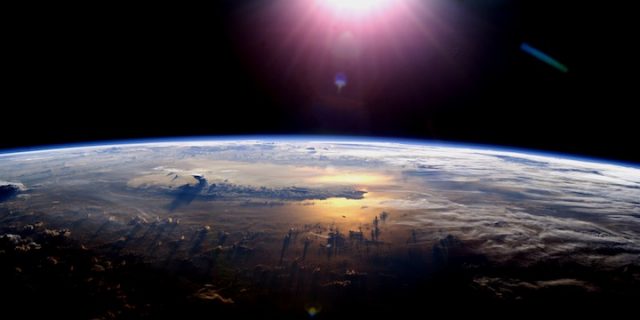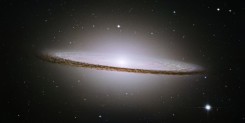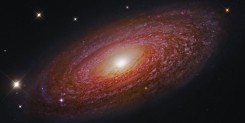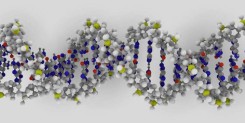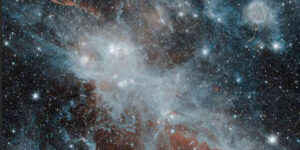Is the earth unique, or are there other planets supporting intelligent life?
If it is finely-tuned for life, does this indicate that God designed it?
Or is there life on millions of planets in our Galaxy or the universe as a whole, showing that life is a common, naturally occurring occurrence?
What is the current scientific consensus on how many earth-like planets are out there, and how many might have intelligent life?
Is Earth specially suited to life?
There are many features of the earth, our solar system, our sun and our galaxy, which make the earth suitable for life as we know it to evolve. (Scientists generally don’t consider the possibilities of life forms not based, like us, on carbon, hydrogen and oxygen, because they think it unlikely that such life could occur and evolve to intelligent life, and because they have no way of estimating how likely such “exotic” life could form.)
Our galaxy
Our solar system is in the right position in the best type of galaxy (spiral). Elliptical galaxies and the centre of spiral galaxies are too unstable for the long process of evolution of life. Elliptical galaxies and the edge of spiral galaxies have far less of the heavier elements which are necessary to form planets like earth, and for life to form.
Our solar system
Our sun, a yellow dwarf, is just the right size and type, and very stable. The more numerous red dwarfs are much less likely to allow life on any orbiting planets, and larger stars are too short-lived for earthlike planets and life to evolve.
The structure of our solar system is optimal for life. The earth is within the “circumstellar habitable zone” that allows liquid water to form on the earth’s surface – 5% closer or further away from the sun and we wouldn’t have surface water, nor the optimum amount of carbon and oxygen. The earth’s orbit is nearly circular, which provides a stable temperature. The larger outer planets’ orbits are also nearly circular, which reduces the gravitational pull on earth and the potential to destabilise earth’s orbit. The larger outer planets act as a comet and asteroid shield protecting earth from fatal collisions.
The earth
Finally, many features of the earth are serendipitous, for example:
- plate tectonics are seen by some scientists to being crucial for a whole range of important earth processes,
- the earth’s albedo (the amount of sunlight reflected rather than absorbed) and the composition of its atmosphere ensures that the earth remains at a suitable temperature,
- our moon is unusually large, which creates larger tides necessary for oceanic processes, but not too large,
- the ‘just right’ mass of the earth retains our beneficial atmosphere and retains heat stored in the earth’s core.
Is the earth close to unique then?
There is no doubt that the earth is in the right place and has the right characteristics to allow life – after all, we wouldn’t be here if it wasn’t! However it is uncertain if this is surprising – after all there are an enormous number of stars and planets.
So how many planets are there, and how likely is it that some of them support intelligent life?
Scientists have tried two different ways to assess this, which we may describe as via science and via statistics.
Evidence for or against other intelligent life
Scientists have tried to work out what factors are likely to allow life, and how many star systems have planets that meet these requirements.
A number of factors (generally about 10-15) are considered important to estimate the likelihood of intelligent life, including:
- The galaxy & stars: the average rate of star formation, the fraction of those stars that have planets.
- The solar system & planets: the average number of planets that can potentially support life per each star that has planets – based on:
- the percentage of stars located in a suitable part of the galaxy,
- physical features of the sun such as type and size,
- the location of the planet in the solar system,
- many other physical attributes required of earth, as noted above.
- Planets: the fraction of planets that have the right conditions to allow life that actually develops into intelligent life
Many attempts have been made to estimate these factors, although many of them are closer to guesses than estimates.
Scientific assessment
Habitable zones
Scientists have have used both observation and guesswork to estimate the number of possibly habitable planets in the universe, based on several calculations and estimations. (There are many different estimates – I have tried to give mid-range figures.)
- Stars in the galaxy: Our sun is one of about 100 billion to 200 billion stars in our Milky Way galaxy (some references suggest 400 billion or more).
- Galaxies in the universe: There are estimated to be about 100 billion galaxies in the known universe. Multiplying these figures together gets an estimate of about 10^23 for the number of stars in the observable universe. (Other estimates vary by an order of magnitude or two, but it doesn’t really matter, the number is “very large”.)
- Planets: It is estimated that there are probably as many planets as stars, which gives an estimate of the order of 10^23 planets in the observable universe.
- Potentially habitable planets: Not all of these planets are in potentially habitable zones around suitable suns. Estimates vary, between 300 million and 10 billion potentially habitable planets in our galaxy, leading to an estimate of around 10^20 in the observable universe.
But how many of these “potentially habitable” planets actually support intelligent life?
Life supporting planets
Many other factors (other than being in the habitable zone of a suitable sun) are required, or at least helpful, to allow life to occur. We should be aware that scientists think it is very much more likely that micro-organisms might exist on a planet than they might evolve into intelligent liffe.
These things help make the earth a stable planet suitable for life:
- The right chemistry – especially water, carbon and metals.
- The right temperature range.
- Enough gravity to retain an atmosphere, and an ozone layer to protect from harmful radiation.
- A solar system that has a large planet (like Jupiter) in an outer orbit whose gravitation limits the number of asteroids and comets coming near to earth.
- Plate tectonics, which continually recycle the earth’s crust and help regulate atmospheric carbon and thus temperature.
- The moon, which causes tides.
Earth’s mineralogy is unique
There is one way in which the earth is definitely unique. A recent paper examined the occurrence of the rare element beryllium on earth. Beryllium is currently known to be an essential component in 122 different minerals, and statistical analysis indicates it probably occurs in 91 other minerals that haven’t yet been discovered.
From this information, the probabilities of the same beryllium minerals occurring on another earth-like planet is found to be very small (about 1 in 10 billion). Extrapolating to other minerals leads to the conclusion that the chances of another planet in the universe duplicating earth’s mineralogy is less than 1 in 10^322. Using an estimate of 10^22 for the number of candidate planets in the universe, the authors conclude: Earth’s mineralogy is unique in the cosmos.
So the earth does appear to be unique in its mineralogy, but of course this says little about whether life is unique, because it is doubtful if many of these possible mineralogies would prevent life if other factors were conducive to life.
The Drake Equation
The Drake Equation attempts to estimate the likely number of civilisations in our galaxy, based on a number of the above factors, many of which can only be guessed. According to Wikipedia, the Drake Equation can give a range of values from indicating that we are alone in our galaxy, and possibly in the universe, up to there being millions of civilisations.
Such a large range suggests the equation is not very useful as an estimate at present, though it does give a direction for future research. But if the best answer is somewhere within this range, and if our galaxy is representative of the approximately 1011 other galaxies (both big “ifs”), life is not so rare in the universe and the earth is not particularly fine-tuned.
But the Drake equation does not consider all of the many other factors now identified which are critical for life and must be considered, and the extrapolation to other galaxies takes no account of the apparent greater suitability of our galaxy. Therefore many question its usefulness.
Rare Earth Equation
On the other hand, Ward and Brownlee, investigating the same questions, developed the Rare Earth Equation, and came to the conclusion that the earth is indeed a rare place and that life is “exceedingly rare in our galaxy and in the universe”. In an interview, Ward indicated he thought microbial life might be common in the universe, but continued to believe complex life is rare.
Others have followed their lead. Hugh Ross has listed 322 factors supporting a rare earth conclusion. This study suggested there were about 10^21 planets in the observable universe, but most were not like earth, and therefore the probability of intgelligent life out there is quite low.
A decade ago Brian Cox also argued against the likelihood of intelligent life elsewhere in the universe, saying that the biological processes which led to the human race on earth were a fluke, and had to overcome a number of “evolutionary bottlenecks” which make it highly unlikely that intelligent life has formed anywhere else. He seems to still share the same doubts today.
All the above factors lead some scientists to conclude that the number of actually habitable planets may be quite small. Maybe only 500 in our galaxy (which might still be 10^12 in the observable universe) or perhaps even less. This AI study concluded there are at least 44 earthlike planets in our galaxy.

Statistical analysesThe Fermi Paradox
The Fermi Paradox
Some scientists (including noted physicist Enrico Fermi) have argued that, if there were other civilisations ‘out there’, some of them would have developed faster than we have, and would have colonised earth by now, or contacted us, or at least left some sign of their presence. But this hasn’t happened, and after decades of searching for signs of extra terestrial intelligence (e.g. by monitoring electromagnetic signals from space), no signs of any life have been found. So, it is argued, there is probably no-one out there.
However calculations done by Forgan and Rice show that if there are other civilisations, they are likely to be either too far away to contact us, or not contemporary with ours because (they suggest) advanced civilisations probably don’t last very long. Other reasons have been raised suggesting that civilisation may be there but we are not aware of them. Some conspiracy theorists, some of them apparently credible observers, argue that we have been visited by aliens or UFOs but governments have hushed this up.
Bayesian analysis
Telescopes and probes have so far found about 6000 exoplanets in our galaxy relatively close to our solar system. (An exoplanet is simply a planet external to our solar system.) About 160 of these have been identified as being in the habitable zone and about 16 show some signs of being earthlike (e.g. presence of water). One has chemicals that can be produced by microbial life.
Some scientists hope that the future may see several space telescopes launched that may be able to use spectroscopy (finding the presence of chemicals from the light reflected by an object) to assess whether exoplanets could possibly support life. Bayesian probability calculations have shown that if 40-80 planets that have been examined are shown not to be suitable for life, then less than 20% of all planets everywhere could be suitable for life. This doesn’t prove very much, but the sources don’t say how many lifeless planets would suggest there was likely no other life in our galaxy.
Bayesian probability has been used to estimate the probability that life would arise on earth, based on how long life took to appear after the conditions were right. The study indicated that primitive life forms were more likely than not to occur, but the odds are just slightly against intelligent life evolving.
However another study suggested that there was a 5/6 chance that life wouldn’t survive enough to evolve to higher forms of life.
Re-assessing the Drake Equation
In 2018, Sandberg, Drexler and Ord re-assessed the Drake Equation, and found that previous calculations were far too subjective, and were statistically misleading. They improved previous estimations in two ways:
- They used more objective methods of assessing the variables in the equation. Principally, instead of using single point estimates at the mid-point of the estimated range for each variable, which grossly overestimates the probabilities, they used a probability distribution based on the uncertainty of the various estimates for each variable. This gave a much reduced estimate of the probabilities of intelligent life in the galaxy and the universe
- Bayesian analysis was used to update this probability in the light of the fact that, as per the Fermi paradox, no signs of other intelligent life have been found.
This represents by far the most sophisticated and reliable estimate of the probability of other intelligent life “out there”. And it yields the following result:
- The probability that we are alone in our galaxy is estimated to be between 53% and 99.6% – i.e. very likely.
- The probability that we are alone in the observable universe is estimated to be between 39% and 85% – i.e. quite likely.
So, is the earth rare?
Until recently, it was impossible to know. There was wide variation in the opinions of those making an assessment.
There is still a wide range of opinions, but it now seems most likely that there are numerous stars and planets, and likely many with primitive microbial life. But it is apparently not very likely that there is other intelligent life in the galaxy. There may be intelligent life out there in another galaxy somewhere, but it is probably too far away to ever make contact.
It seems astronomers are more likely to believe there is other life out there, because of the immense number of stars and planets, while biologists tend to see complex life as much less likely because of all the barriers evolution has to overcome.
Does a rare earth point to God?
Some Christians (e.g. Hugh Ross) believe human life is unique in the universe and a life-supporting planet like earth is so unlikely that belief in God as creator is the only explanation.
On the other hand, some sceptics take the view that a universe where life is absent almost everywhere shows that it isn’t very well designed, and so wasn’t created by a God.
Neither of these arguments seem very strong to me. I think both belief or disbelief in God can fit the evidence we have, either for a lonely universe or a universe teeming with life.
I suppose the unlikelihood of other intelligent life may slightly increase the possibility that God created life, but I wouldn’t think I’d ever want to make such an argument.
My personal view is that there is likely intelligent spiritual life elsewhere in the universe but not in our galaxy, and I think it very likely that primitive life in many places in many places but rarely evolves much. I can’t help feeling that God wouldn’t want us coming into contact with other civilisations and going to war with them like we so often do among nations on earth. So whatever life there may be is probably galaxies apart!
Top photo: Earth from spaceNASA. Second photo: Andromeda galaxy, the nearest galaxy to our own Milky Way galaxy (NASA).
Feedback on this page
Comment on this topic or leave a note on the Guest book to let me know you’ve visited.
